- United States Department of Agriculture (USDA), Agricultural Research Service (ARS), Range Sheep Production Efficiency Research Unit, U.S. Sheep Experiment Station, Dubois, ID, United States
Lamb survivability is an important trait from both an economic and animal welfare perspective. Five breeds at the U.S. Sheep Experiment Station were evaluated for survival to weaning and included 74,448 records from 43 years. Objectives were to evaluate 1) the influence of lamb and littermate competition on lamb survivability to 3 d and 120 d (weaning); 2) the influence of within-litter competition on birth weight; 3) the relationship between within-litter birth weight deviation and lamb survivability, 4) the influence of ewe age on lamb survivability and birth weight, and 5) reasons for and timing of lamb loss. Sex of littermate(s) had an impact on lamb survivability, which was more pronounced for triplets than for twins. Although not significant, female birth weights were lighter in mixed-sex litters than all-female litters. Within-litter birth weight deviation had an impact on lamb survivability with lambs from below mean weight litters that were more than 1 kg lighter than the litter having less than a 50% chance of survival. Both young and old ewes had lower lamb survival than mid-age ewes. Reasons for lamb loss differed depending on the age of the lamb with weak and trauma categories resulting in early loss and predation resulting in later loss. This study provides insight into within-litter competition for use in future genetic evaluation.
Introduction
Causes and factors influencing lamb loss have been reported for at least 75 years (Venkatachalam et al., 1949) without considerable improvement in the trait. Production inefficiencies in lamb survivability continue to persist with an increase in lamb mortality from 10.6% to 11.5% since 2000 (USDA-NASS, 2021). The value of lamb loss in the U.S. in 2019 was $72.6 million, with 40.1% of loss due to predation with weather-related events, internal parasites, and lambing issues rounding out the top non-predation losses (USDA-APHIS, 2022). These production inefficiencies are jeopardizing the sustainability of the U.S. sheep industry, which has seen inventories contract (1 to 2% annually) despite a robust market demand for lamb (USDA-NASS, 2024). Both productivity and animal welfare require that we continue to deconstruct the components that we can influence in order to make improvements in this economically important trait.
In-utero factors
Sex influences are present in-utero, with all-male litters having heavier cotyledons than all-female litters and mixed-sex litters intermediate between the two (Dwyer et al., 2005). McDonald et al. (1981) found fetal weight of males to be heavier than females, even after accounting for differences in cotyledon weight. The heavier birth weights of males in mixed-sex twin litters was twice the difference between birth weights of same-sex litters (Donald and Purser, 1956), which they hypothesized was due to the male co-twin being able to outcompete his female co-twin for nutrients in-utero.
Triplets have less placental efficiency, defined as fetal weight per gram of placenta, than twins or singles, reducing their birth weights and resulting in neurological deficiency evidenced by lambs at birth that are uncoordinated and slow to nurse, even after adjusting for birth weight (Dwyer et al., 2005). The authors attributed this neurological deficiency for triplets at birth to placental insufficiency leading to insufficient nutrient delivery in late gestation. Additionally, lambs with lighter placentas were associated with lower adipose tissue and an inability to maintain temperature when faced with a cold environment. Triplets had a lower rectal temperature, further providing evidence for an inability to maintain their temperature, which can lead to impaired performance (Dwyer et al., 2005).
In swine, an increase in number born can reduce the homogeneity of piglet birth weight, reducing piglet survival to weaning (Damgaard et al., 2003). This problem may be exacerbated in sheep since the ewe’s uterus is comprised of two short uterine horns whereas the sow has two long uterine horns for multiple fetuses to attach. McDonald et al. (1981) showed that twins had less variation in fetus weights than triplets and quadruplets. Twin lamb fetuses are typically located in separate horns, fairly competing for nutrients. In triplets, one lamb tends to get one uterine horn and two lambs share the other, increasing variability in fetal weights. The fetus with a uterine horn to itself is presumably at an advantage over its littermates), with increased competition existing between the fetuses sharing a uterine horn (McDonald et al., 1981; Everett-Hincks et al., 2005).
Birth weight
Male lambs are typically heavier at birth than female lambs (Fogarty et al., 2000; Dwyer et al., 2005; Everett-Hincks et al., 2014; Juengel et al., 2018), yet males have lower survival than females (Venkatachalam et al., 1949; Dalton et al., 1980; Petersson and Danell, 1985; Gama et al., 1991; Lopez-Villalobos and Garrick, 1999; Riggio et al., 2008; Everett-Hincks et al., 2014; Juengel et al., 2018). Exceptions to this included lower survival of females in mixed-sex twin litters (Kenyon et al., 2011) and lower survival of females in triplet litters but not in single or twin litters (Everett-Hincks et al., 2005). Based on observed behaviors within 2 hours of birth, Dwyer et al. (2005) observed males were slower than females for most behaviors related to standing and reaching the udder of the dam. Korsten et al. (2009) reported females in mixed sex litters were lighter at birth than female-female twin litters.
Increases in litter size are associated with decreased individual lamb weights, where single lambs weigh more than twin lambs who weigh more than triplet lambs (Dalton et al., 1980; Fogarty et al., 2000; Dwyer et al., 2005; Juengel et al., 2018). Dwyer et al. (2005) reported a decrease of 1 kg per lamb birth weight for each increase in litter size. For each increase in litter size, lamb survivability tends to decrease (Venkatachalam et al., 1949; Dalton et al., 1980; Petersson and Danell, 1985; Lopez-Villalobos and Garrick, 1999; Riggio et al., 2008; Juengel et al., 2018), although Everett-Hincks et al. (2005) found twin survival to be higher than single lambs which were higher than triplet lambs. Dalton et al. (1980) reported differences in survival for litter size to be primarily attributed to differences in birth weight. Everett-Hincks et al. (2005) suggested the increased competition faced by triplets forces them to draw on their own ability to survive rather than rely on their dam, indicating lamb survivability is a different trait, or has a different degree of expression, for singles, twins, and triplets. One justification for this is the disadvantage faced by triplet lambs since the ewe normally has only two functional teats, forcing greater littermate competition for postnatal resources for triplets as compared to twins or singles.
Birth weight related to lamb survival is frequently reported as an intermediate optimum, where light birth weights are associated with death due to starvation and exposure and heavy birth weights are associated with death due to dystocia (Dalton et al., 1980; Gama et al., 1991; Everett-Hincks and Dodds, 2008). For lambs with a large disparity in birth weight within a litter, lamb survival has a tendency to be lower with the lightest lamb having the lowest survival (Everett-Hincks and Dodds, 2008; Morel et al., 2009; Juengel et al., 2018). Reducing the difference in birth weight between lambs in a litter would provide an opportunity to increase lamb survivability of the litter. Everett-Hincks and Dodds (2008) reported lambs more than 1 kg above the mean birth weight have greater survival with the lowest survival among triplets that were lighter than the mean birth weight. Venkatachalam et al. (1949) reported lambs much lighter than the mean birth weight of the breed had little chance of survival.
Ewe age
Lambs born to first parity dams were found to have smaller and less efficient placentas with lambs that were slower to stand and reach the udder than parity two and three dams. The authors suggested lambs from first parity dams were at a further disadvantage in terms of maternal care, including immature physiological and neuroendocrinological responses to their lambs relative to multiparous ewes (Dwyer et al., 2005). Primiparous ewes tend to have lambs with lighter birth weights and lower survival than multiparous ewes (Dwyer et al., 2005; Everett-Hincks et al., 2005; Riggio et al., 2008; Everett-Hincks et al., 2014; Juengel et al., 2018).
Reasons for lamb loss
Lamb loss is often reported in time periods, such as within 24 hours of birth or in the first 3 or 4 days of birth and also as lamb loss to weaning. Most studies report the first 3 days after lambing to be the most critical for survival (Dalton et al., 1980; Everett-Hincks and Dodds, 2008; Everett-Hincks et al., 2014). Everett-Hincks et al. (2014) reported 2/3 of lamb loss occurred in the first 3 days after lambing. In their study, they performed a postmortem procedure on lambs that died by day 3 and assigned them as death due to dystocia, starvation-exposure, or other. Some studies included additional categories for lamb loss, including respiratory, digestive, starvation, injury, and other/unknown (Gama et al., 1991). Venkatachalam et al. (1949) reported lamb loss due to pneumonia, premature birth, weak lambs, abnormalities, and other; some authors reported additional categories (Mukasa-Mugerwa et al., 2000; Holmøy et al., 2017). Although the financial impact of predation on lamb loss has been documented (USDA-APHIS, 2022), no scientific literature was identified to document the timing and impacts of lamb loss on flocks in the U.S.
Studies of lamb survivability are inherently complex because survival is an all-or-nothing trait that requires cooperation from the ewe and the lamb starting in-utero and continuing through weaning (Gama et al., 1991). At any point along the trajectory towards weaning, lamb loss could occur for a multitude of reasons that are environmental, genetic, or a combination of both. Since lamb survivability is phenotypically expressed as a binary trait, threshold models are appropriate for estimating variance components. However, linear models continue to be used as well. Kelly et al. (2016) used linear methods to estimate heritability for lamb survivability as separate traits for singles, twins, and triplets, with heritability estimates of 0.01, 0.04, and 0.15, respectively, compared to 0.02 for the combined data. Using similar methods, Hebart and Brien (2018) reported heritability estimates of 0.04, 0.06, and 0.04 for singles, twins, and multiples, respectively, and 0.04 for overall lamb survivability. For threshold models, direct heritability ranged from 0.01 to 0.28, maternal heritability ranged from 0.03 to 0.26, and the permanent environment of the ewe ranged from 0.07 to 0.10 (Lopez-Villalobos and Garrick, 1999; Matos et al., 2000; Everett-Hincks et al., 2002; Welsh et al., 2006; Casellas et al., 2007; Cloete et al., 2009). Both Brown et al. (2014) and Everett-Hincks et al. (2014) estimated heritabilities for components of lamb loss (e.g., starvation, dystocia), but found the estimates for overall lamb survival to be higher.
Breeds
Of the five breeds included in this study, three are maternal dual-purpose (Polypay, Rambouillet, and Targhee) and two are terminal sire breeds (Suffolk and Paternal Composite (PC; 3/8 Columbia, 3/8 Suffolk, 1/4 Texel)). The Polypay was developed at the USSES beginning in 1968 with equal contributions from Dorset, Rambouillet, Targhee, and Finnsheep (Hulet et al., 1984). The Polypay was developed to be a prolific range ewe, and its versatility has expanded throughout the U.S. to include intensive management and inclusion in accelerated lambing systems (Vanimisetti and Notter, 2012; Hulet and Stellflug, 2019). The Rambouillet is dual-purpose, producing both lambs and a high-quality fleece. The Targhee was established in 1926 at the USSES from Rambouillet rams crossed with Corriedale x Lincoln-Rambouillet and Lincoln-Rambouillet ewes (Terrill, 1947; USTSA, 2023). Both the Rambouillet and Targhee are representative of the “Western white-face” ewe seen throughout the region. While the Targhee are predominantly located in Montana, the Rambouillet are utilized throughout the U.S. with a historically large population in Texas. The Suffolk is the primary terminal sire breed used throughout the U.S. producing fast-growing lambs and excellent carcass characteristics (Notter et al., 2012), but has a reputation for a lack of longevity. The development of the PC line at began at USSES in 2006 and was described by (Vargas Jurado et al., 2022). The PC was selected for lamb survival, growth, efficiency, and carcass traits (McKibben et al., 2019). Performance of Suffolk and PC-sired crossbred lambs at USSES has been reported (McKibben et al., 2019; Notter and Taylor, 2019).
For five breeds at the U.S. Sheep Experiment Station (USSES), the objectives of this study were to evaluate 1) the influence of lamb and littermate competition on lamb survivability to 3 d and 120 d (weaning); 2) the influence of within-litter competition on birth weight; 3) the relationship between within-litter birth weight deviation and lamb survivability, 4) the influence of ewe age on lamb survivability and birth weight, and 5) reasons for and timing of lamb loss. We hypothesized the highest lamb survivability would be for uniform birth weight twin litters from mid-age ewes. The results will be used to provide greater understanding of the lamb survivability trait and to define contemporary groups and fixed effects for future genetic evaluation.
Materials and methods
Animal care
The USSES Institutional Animal Care and Use Committee (IACUC) approved all husbandry practices and experimental procedures used in this study.
Description of animals and management
Sheep included in this research were from the USSES near Dubois, ID. Although a research flock, where a small contingent would have been managed differently for various projects (feeding trials, grazing trials), the vast majority of sheep were managed as described. Breeding occurred in October in single-sire matings with 20-30 ewes with the exception of ewe lambs, who were mated in multi-sire pens to terminal sires. After breeding, ewes grazed native shrublands (before 2013) or alfalfa and crop-aftermath fields (after 2013) from late fall to early winter (Wilmer et al., 2024). When climatic conditions (e.g., snowpack) prohibited grazing, ewes were returned to drylots until lambing. Lambing began in early spring and was managed as a shed-lambing system. Ewes lambed in drylots and were immediately moved indoors for 36 to 48 h, then returned to the drylots with lambs for approximately 35 d before being turned out to graze rangelands. Traditionally, large range flocks in the Western U.S. follow a system of seasonal transhumance where ewes and their lambs are herded up in elevation throughout the grazing season to take advantage of the short growing season at high altitude and make the most of available forage and cooler summer temperatures. Then, the sheep are moved back down to take advantage of the longer growing season at lower elevations. Grazing typically includes both private and public lands with forage including sagebrush steppe and/or montane forest. Sheep were managed in bands of 800 – 1,000 sheep with a herder present. Like other U.S. Western range flocks, this has been the spring to late summer grazing system for maternal breed sheep at the USSES (Wilmer et al., 2024). After weaning in late summer, ewes continued to graze sagebrush steppe until breeding. Due to a lack of gregariousness, terminal sire breeds were maintained on fenced, improved pasture from spring to late summer where they were closely monitored for predators (coyotes, wolves, bears).
Data description
Historical records from the five breeds were reported from 1980 to 2023, except for the PC, which began inter se mating in 2009. Lambs were weighed and tagged within 24 hours of birth. Typically, triplet litters were reduced to twin litters unless the litter was to remain intact for a research project (Notter et al., 2018). Surplus lambs were either fostered to another ewe or orphaned and sold. Data from those litters were removed from the dataset since fostered lambs had two different maternal environments and orphaned lambs had an unknown lamb survival outcome. As such, only intact litters were included in the analysis. For maternal breeds, quadruplet and higher order litters were removed from the analysis and, for terminal sire breeds, triplet and higher order litters were removed. After data filtering, there were a total of 22,047 Polypay, 24,640 Rambouillet, 20,297 Targhee, 3,789 Suffolk, and 3,675 PC lamb records included in the analysis. This included 603 sires and 5,861 dams for Polypay, 786 sires and 5,628 dams for Rambouillet, 697 sires and 4,319 dams for Targhee, 180 sires and 953 dams for Suffolk, and 150 sires and 1,129 dams for the PC. Lambs with a death code between their date of birth and 3 days of age were considered not to survive to day 3 (LS3). Lambs with a weaning weight were considered to have survived to weaning (LSW).
Statistical methods
Litter sex composition and litter birth weight variation were the primary considerations for influencing competition. Lamb survivability to 3 d (LS3) and 120 d (LSW) were analyzed using a Bayesian logistic regression model with the logit link function in the rstanarm package in R (Goodrich et al., 2020; R Core Team, 2023). Lamb survivability was assumed binomially distributed and influenced by age of dam, birth year, lamb sex, and sex of littermates as fixed effects. Litter was included as a random effect to account for the non-independence of lambs from the same litter. Least squares means were transformed from the log odds scale to the probability scale. The Bayesian equivalent of 95% confidence intervals were obtained by calculating the values of the estimates that bound 95% of the posterior distributions [highest posterior density (HPD) intervals] (Martin and Videlier, 2022). Birth weight was assumed normally distributed and influenced by the same fixed effects as lamb survival and was analyzed using a linear mixed model using the lme4 package in R (Bates et al., 2015). Lamb survivability to 3 days (LS3-Adj) and lamb survivability to weaning (LSW-Adj) were also analyzed using the same model described above but included mean litter weight as linear and quadratic covariates and individual birth weight deviation as a linear covariate. Accounting for mean litter birth weight and individual birth weight deviation removed the birth weight differences between the sexes, leaving only true sex differences between lambs for survivability.
Reasons for lamb loss were grouped into seven categories: respiratory, predation, gastro-intestinal, starvation-exposure, weak, trauma, and other/unknown. For each breed, the lamb loss categories were summarized by the percentage of total lamb loss they comprise. The cumulative mortality for each lamb loss category was summarized by age.
Results
Influence of lamb and littermate competition on lamb survivability to weaning
For LS3 and LS3-Adj, no significant differences were found within each litter-sex combination for any breed for either model (Table 1). For LSW-Adj, significant differences were found within litter-sex combinations for all breeds except Suffolk. Because the LSW-Adj model shows true sex differences between lambs, this model was the main focus of the results.
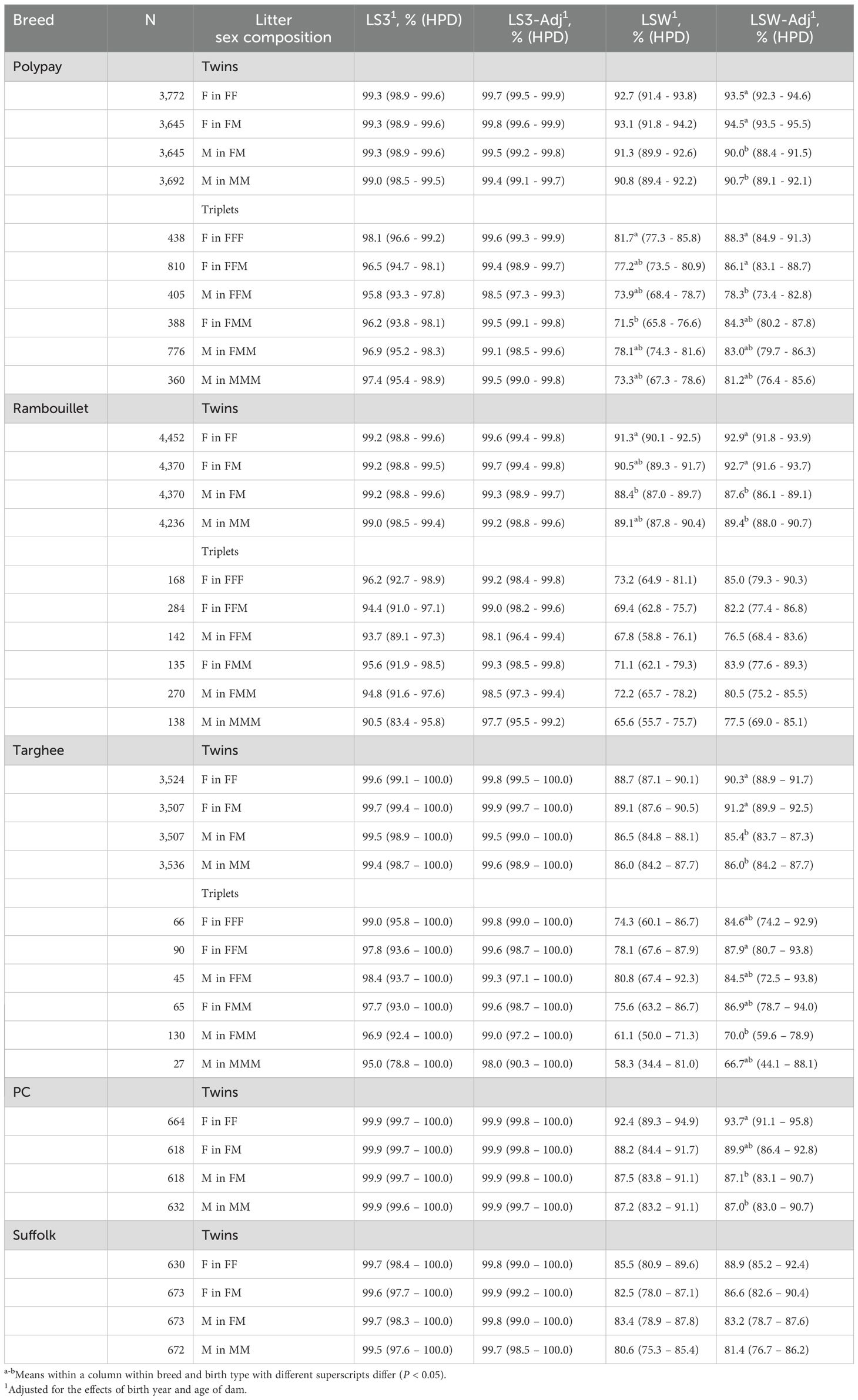
Table 1. Least squares means (LSM) and their 95% highest posterior density (HPD) intervals for lamb survival percentages to 3 days (LS3) and weaning (LSW) and lamb survival percentages to 3 days (LS3-Adj) and weaning (LSW-Adj) adjusted for within-litter birth weight, by type of birth, male (M) and female (F) sex, and sex of littermates.
For Polypay twins, females (F) in mixed-sex litters (FM) had a 4.5% higher survival than males (M) in mixed-sex litters (P < 0.05). Although not significant, F in FM had a 1% higher survival than F in all-female litters (FF). The opposite was true for M in FM, where they had a 0.7% lower survival than M in MM litters (Table 1; Figure 1A). For Polypay triplets, the lowest survival was observed for M in female-female-male (FFM) litters, where they had a 7.8% lower survival than the F in the same litter (P < 0.05). While not significant, M in FFM had a 4.7% lower survival than M in female-male-male (FMM) litters. The highest survival observed in Polypay triplet litters was for F in female-female-female (FFF) litters (Table 1; Figure 2A). When born a F, Polypay singles and twins had a survival advantage over triplets (P < 0.05; Figure 3A). Polypay M singles and twins had a survival advantage over triplets (P < 0.05; Figure 4A).
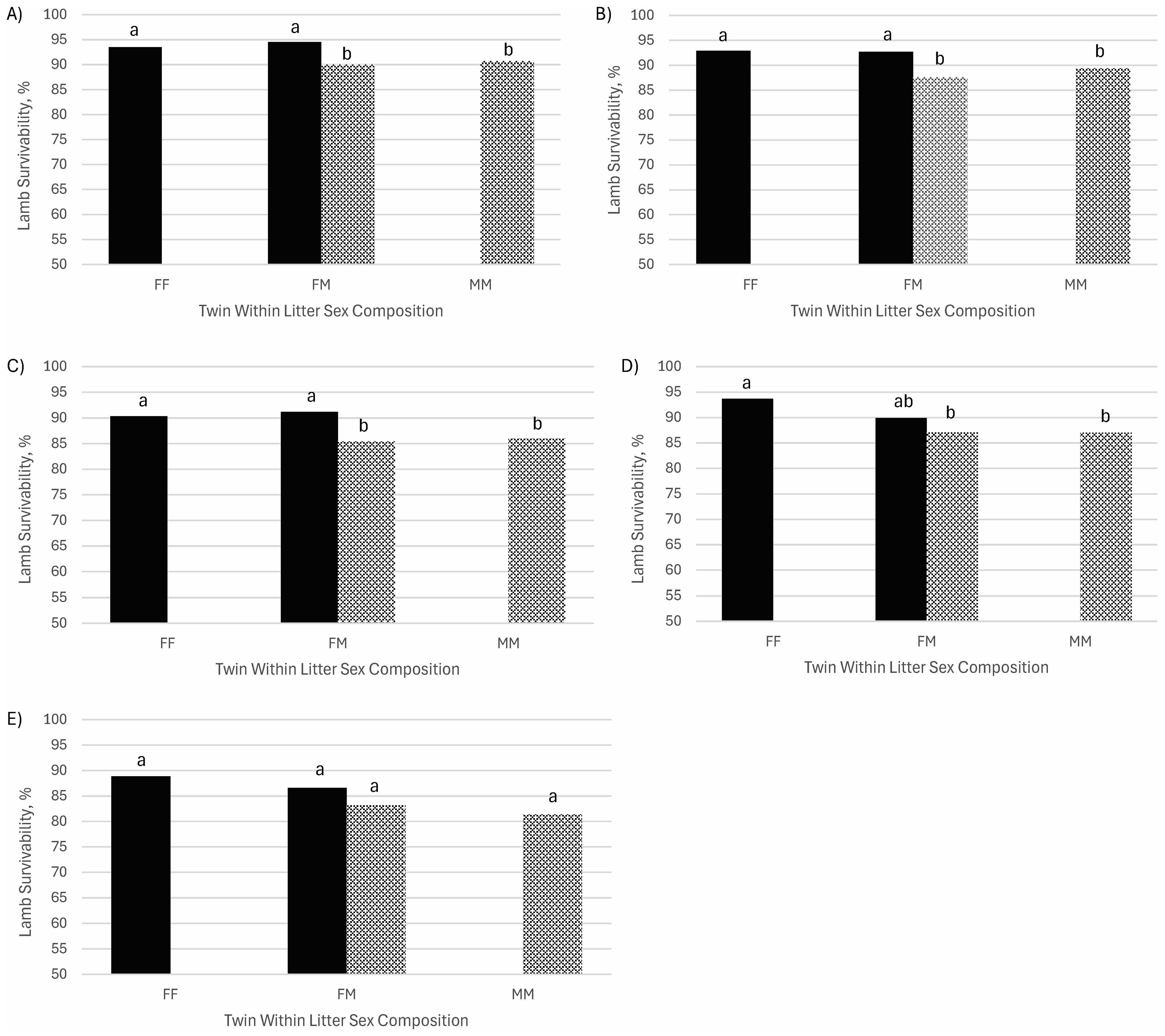
Figure 1. Lamb survivability (%) by twin within litter sex composition for Polypay (A), Rambouillet (B), Targhee (C), PC (D), and Suffolk (E). Within breed, bars with different letters differ (P < 0.05).
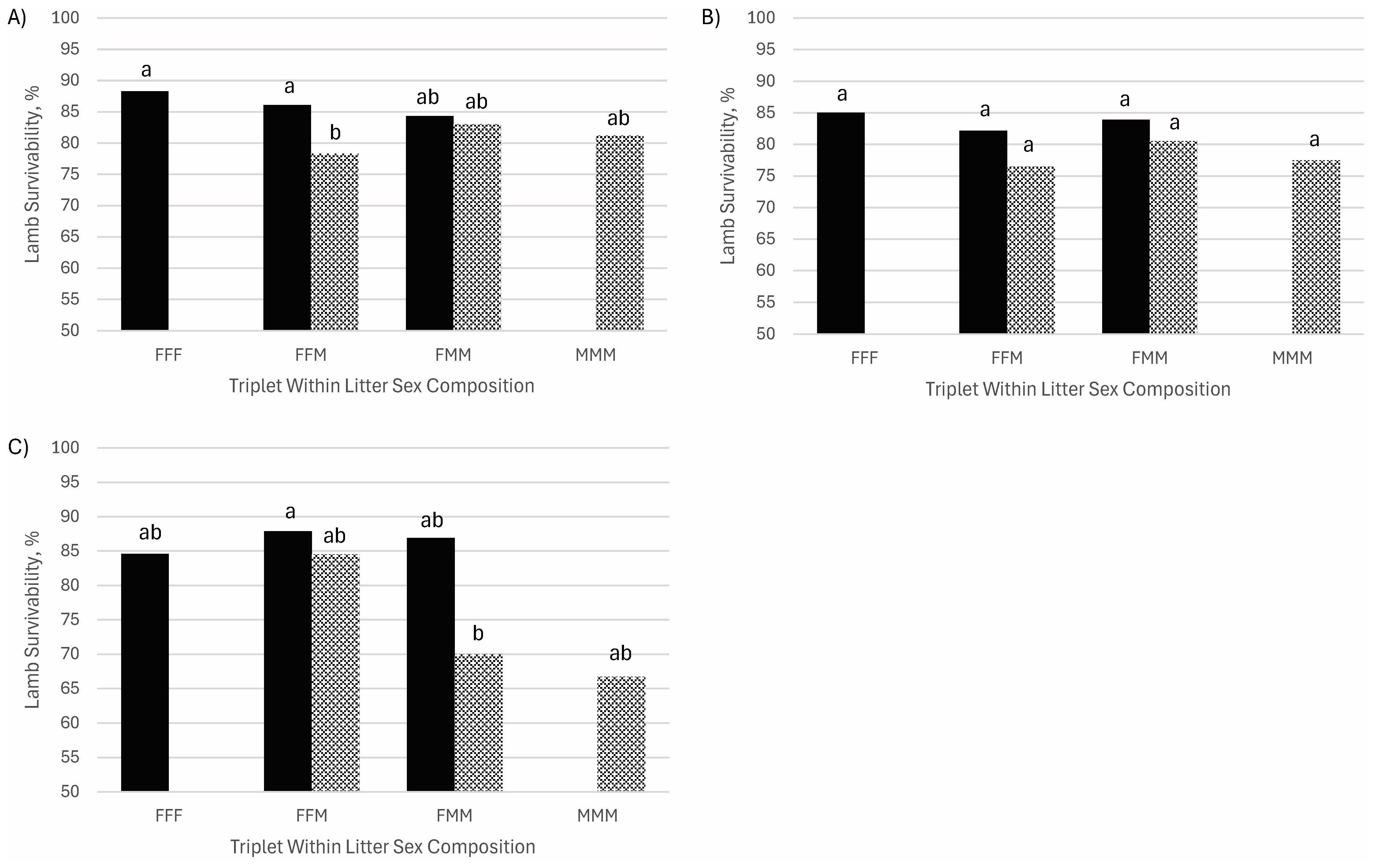
Figure 2. Lamb survivability (%) by triplet within litter sex composition for Polypay (A), Rambouillet (B), and Targhee (C). Within breed, bars with different letters differ (P < 0.05).
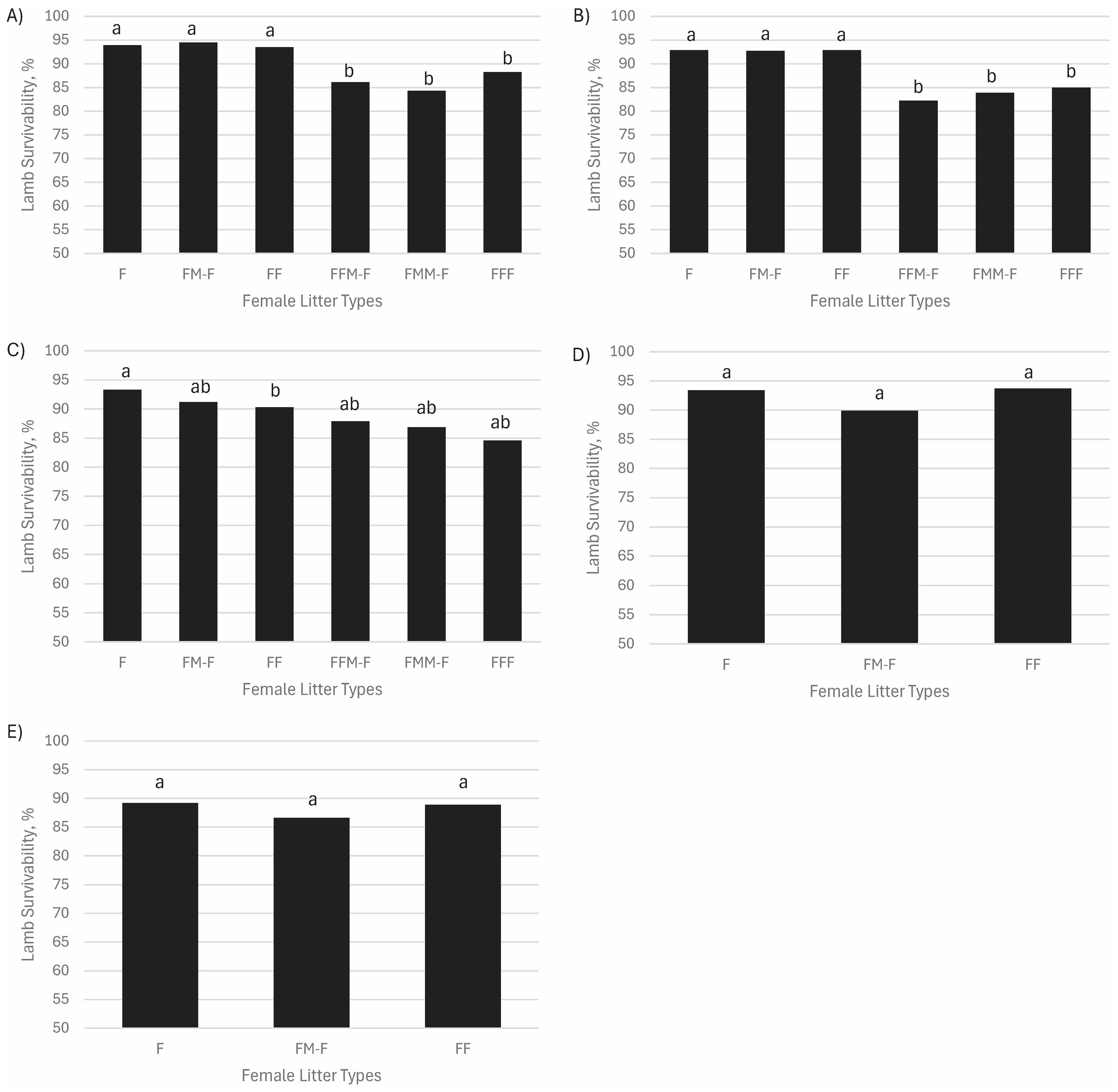
Figure 3. Lamb survivability (%) for all female litter types for Polypay (A), Rambouillet (B), Targhee (C), PC (D), and Suffolk (E). Within breed, bars with different letters differ (P < 0.05).
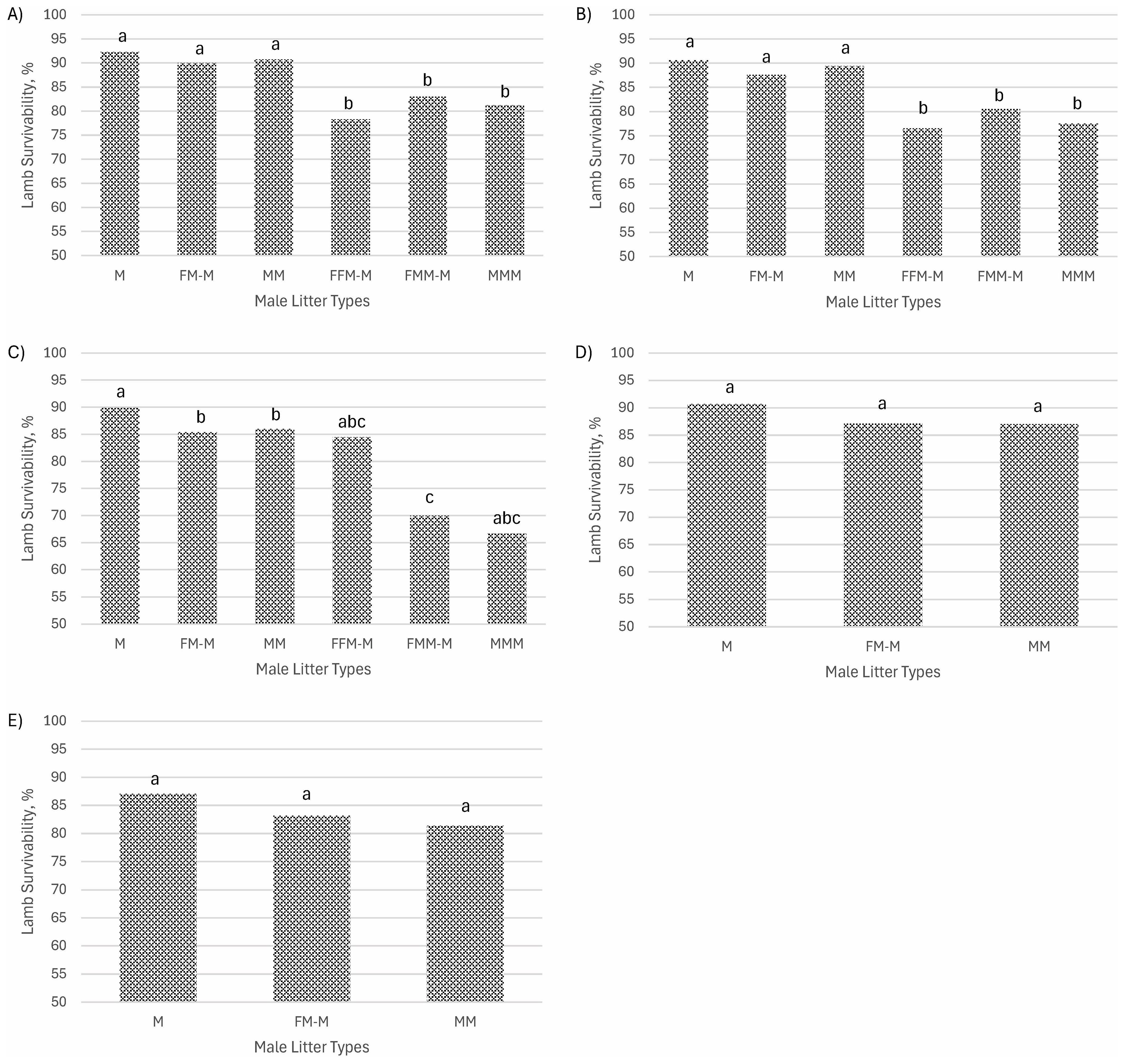
Figure 4. Lamb survivability (%) for all male litter types for Polypay (A), Rambouillet (B), Targhee (C), PC (D), and Suffolk (E). Within breed, bars with different letters differ (P < 0.05).
Within mixed-litter twins, F Rambouillet lambs had a 5.1% survival advantage over their M co-twin (P < 0.05; Table 1; Figure 1B). For Rambouillet triplets, although not significant, F in FFF had a 7.5% higher survival than M in MMM litters. Similar to Polypay lambs, Rambouillet M in FFM had a 4.0% lower survival than M in FMM litters (Table 1; Figure 2B). Rambouillet F singles and twins had a significant survival advantage over their F triple counterparts (P < 0.05; Figure 3B). Similarly, M singles and twins had a higher survival than M triplets (P < 0.05; Figure 4B).
Targhee F in FF litters had a 4.3% survival advantage over M in MM litters (P < 0.05; Table 1; Figure 1C). Within mixed-sex Targhee litters, F had a 5.8% higher survival than their M co-twin (P < 0.05). Different from Polypay and Rambouillet, the Targhee M in FFM litters had a higher survival than M in FMM litters (14.5%; P > 0.05; Table 1; Figure 2C). When born a F, Targhee single lambs had a 8.7% higher survival than F in FFF litters (P > 0.05; Figure 3C). When born a M, Targhee single lambs had a 23.2% higher survival than M in MMM litters (P > 0.05; Figure 4C).
All-female PC twin litters had 6.7% higher survival than all-male twin litters (P < 0.05; Table 1; Figure 1D). Within the mixed-sex twin litters, F had a non-significant 2.8% higher survival than M. When comparing F in FF and F in F-FM, there was a 3.8% advantage for F in FF. When born a F, lamb survival was not significantly different across single and twin litters. The FF litters had a slightly higher survival than F litters (Figure 3D). Lamb survival was not significantly different among M in single and twin litters, but M in single litters had a 3.6 and 3.7% higher survival than M in FM and MM litters, respectively (P > 0.05; Figure 4D).
Competition within litter-sex was not significant for Suffolk (P > 0.05; Table 1). However, F in FF litters had a 7.5% higher survival than M in MM litters. Within mixed-sex litters, the F had a 3.4% higher survival than their M co-twin. When comparing F in FF and F in FM litters, the F in FF had 2.3% higher survival (Table 1; Figure 1E). When born a F, lamb survival was 89.2, 86.6, and 88.9% for F, FM, and FF litters, respectively (Figure 3E). When born a M, lamb survival was 87.1, 83.2, and 81.4% for M, FM, and MM litters respectively, with the largest difference of 5.7% between M and MM (Figure 4E).
Influence of within-litter competition on birth weight
Polypay M in FM and MM litters have heavier birth weights than F in FM and FF litters (P < 0.05; Table 2; Figure 5A). Within mixed-sex twin litters, M weigh 0.31 kg more than their F co-twin (P < 0.05). For triplet litters, M in mixed-sex litters (FFM and FMM) weighed significantly more than their F littermates (P < 0.05; Figure 6A). The M in MMM litters were lighter than the other M litter-sex combinations, but heavier than the F litter-sex combinations (P > 0.05). The lightest F were from FMM litters and weighed 0.36 less than their M littermates (P < 0.05).

Table 2. Least squares means (LSM) and their 95% confidence limits (CL) intervals for birth weight by type of birth, male (M) and female (F) sex, and sex of littermates.
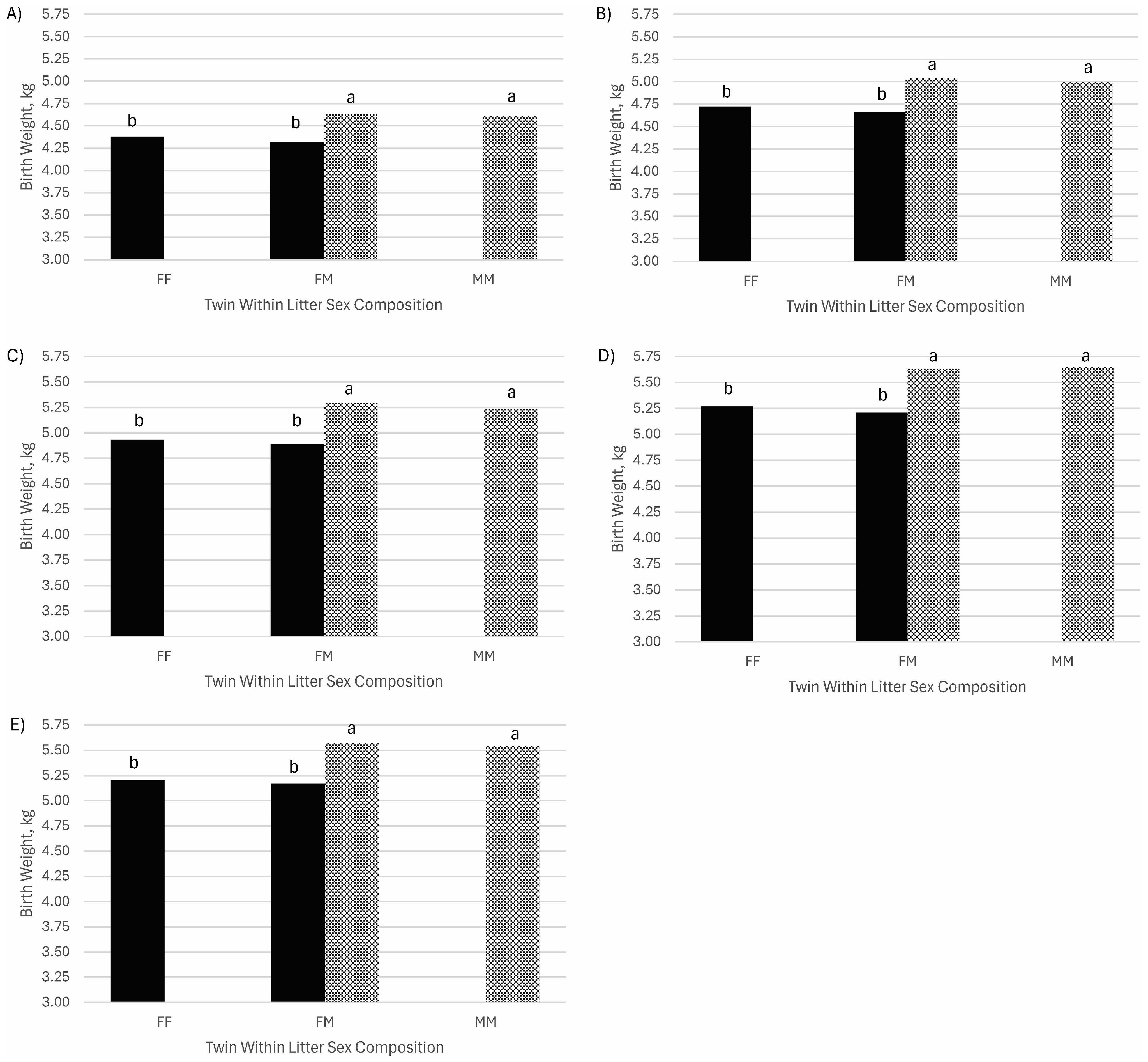
Figure 5. Birth weight (kg) by twin within litter sex composition for Polypay (A), Rambouillet (B), Targhee (C), PC (D), and Suffolk (E). Within breed, bars with different letters differ (P < 0.05).
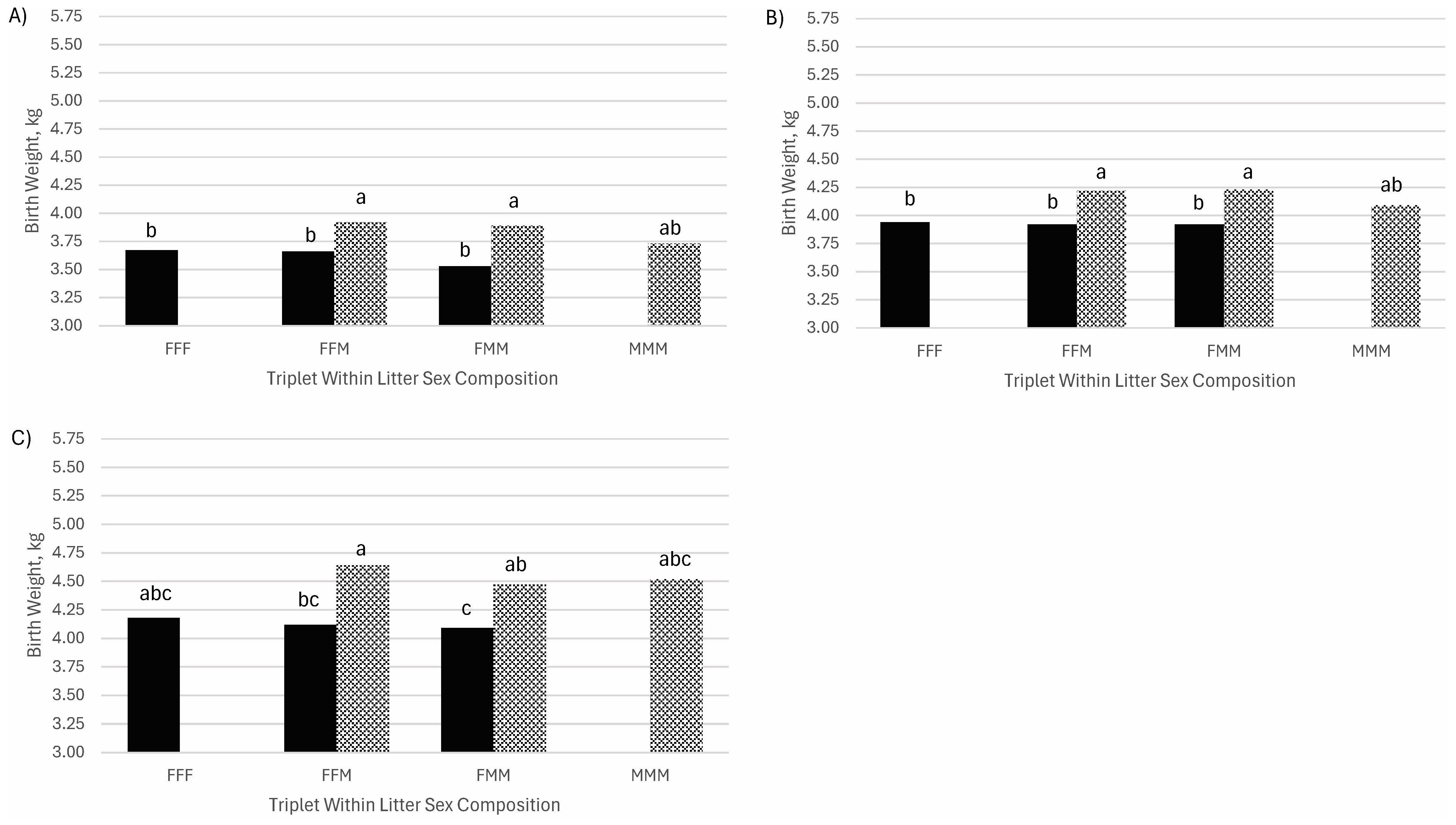
Figure 6. Birth weight (kg) by triplet within litter sex composition for Polypay (A), Rambouillet (B), and Targhee (C). Within breed, bars with different letters differ (P < 0.05).
The same trends were observed for Rambouillet twins and triplets as with the Polypay lambs. For Rambouillet twins, M in FM and MM litters weighed more at birth than F in FM and FF litters (P < 0.05; Table 2; Figure 5B). in the FM litters, M weighed 0.38 kg more than their F littermate (P < 0.05). For triplets, M in FFM and FMM weighed more than their F littermates (P < 0.05; Figure 6B). The M in MMM litters were intermediate between the M in mixed-sex litters and the F in all of the triplet litters (P > 0.05). The F in triplet litters differed by 0.02 kg while the M in triplet litters differed by 0.14 kg.
Targhee M in twin litters (FM and MM) were significantly heavier than F in twin litters (FM and FF) with the M in FM litters weighing 0.40 kg more than their F co-twins (P < 0.05; Table 2; Figure 5C). For triplet Targhee litters, the heaviest litter-sex category was M in FFM, who weighed 0.52 kg more than their F littermates (P < 0.05; Figure 6C).
For the PC, the F in FF and FM twin litters had similar birth weights, 5.27 and 5.21 kg, respectively. The M in MM and FM twin litters were also comparable, with birth weights of 5.65 and 5.63 kg, respectively. The M in both MM and FM litters had significantly heavier birth weights than the F in FM and FF litters (P < 0.05; Table 2; Figure 5D). Within the FM litters, M had 0.42 kg heavier birth weights than F (P < 0.05).
For Suffolk, the F in FF and FM twin litters were similar for birth weight as were the M in MM and FM twin litters (Table 2; Figure 5E). The M in MM and FM litters were significantly heavier than the F in FF and FM litters (P < 0.05). When comparing the mixed-sex litters, M were 0.40 kg heavier than F (P < 0.05).
Relationship between within-litter birth weight deviation and lamb survivability
For the Polypay, lamb survivability was plotted separately for twin litters that were above or below the mean birth weight of 4.29 kg and by individual birth weight deviation from the litter mean birth weight. The same approach was used for triplet litters that were above or below the mean birth weight of 3.79 kg (Figure 7A). Twins from below mean litter weights and individual birth weight deviation of more than 1 kg lighter than the mean litter weight had 19% lower survival than those from above mean litter weights (56 vs 75%). Twins from below mean litter weights and individual birth weight deviation of more than 1 kg heavier than the mean litter weight had 1% lower survival then those from above mean litter weights (97 vs 98%). For triplets with individual birth weight deviation of more than 1 kg lighter than the mean, the below mean litters had 16% lower survival than the above mean litters (31 vs 47%). For triplets with individual birth weight deviation more than 1 kg heavier than the mean, the below mean litters had 4% lower survival than the above mean litters (91 vs 95%).
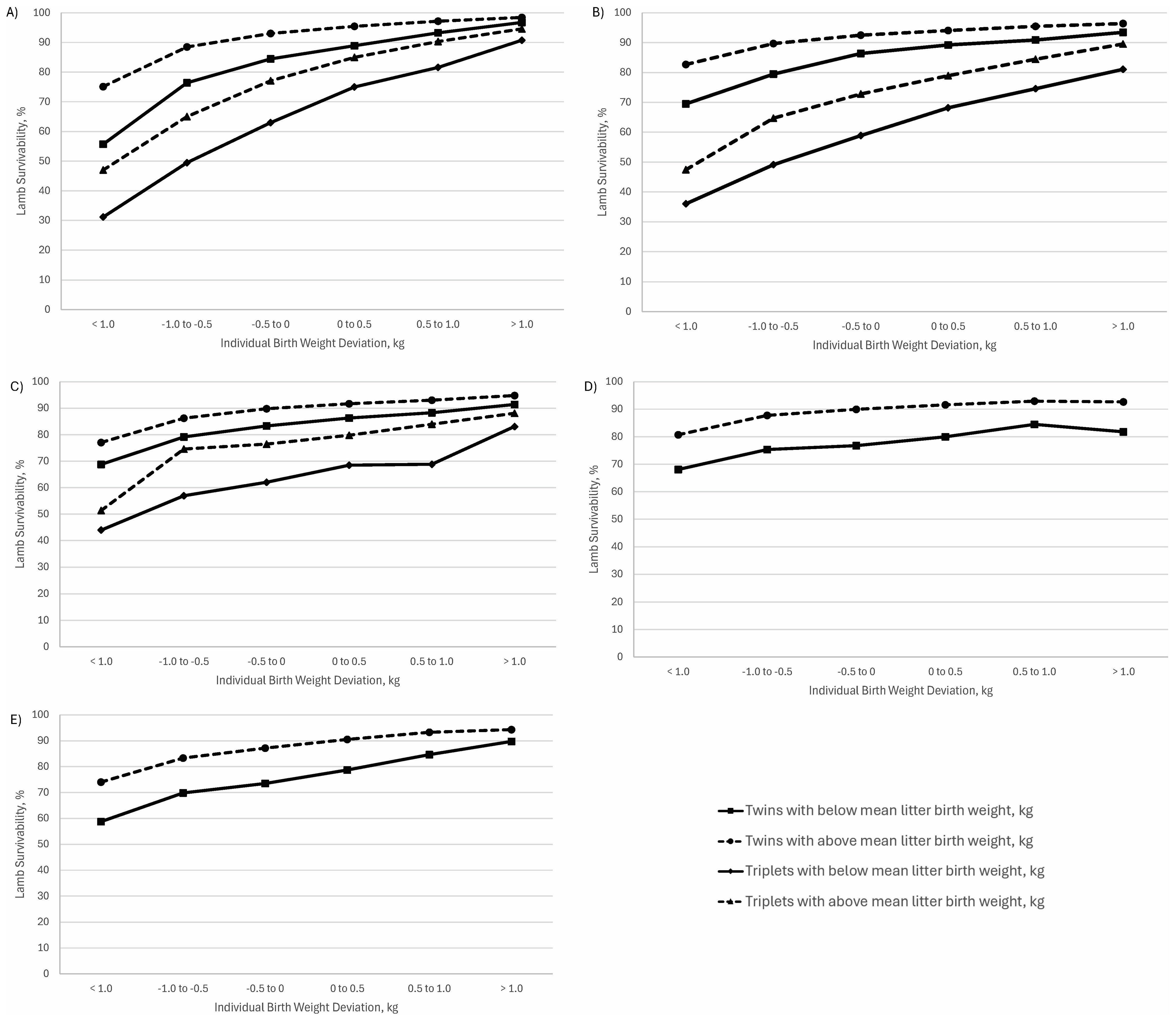
Figure 7. Lamb survivability (%) by within-litter birth weight deviation (kg) for above and below mean litter weight twins and triplets for Polypay (A), Rambouillet (B), Targhee (C), PC (D), and Suffolk (E).
For the Rambouillet, lamb survivability was plotted separately for twin litters that were above or below the mean birth weight of 4.86 kg and by individual birth weight deviation from the litter mean birth weight. The same approach was used for triplet litters that were above or below the mean birth weight of 4.22 kg (Figure 7B). Twins from below mean litter weights and individual birth weight deviation of more than 1 kg lighter than the mean litter weight had 14% lower survival than those from above mean litter weights (69 vs 83%). Twins from below mean litter weights and individual birth weight deviation of more than 1 kg heavier than the mean litter weight had 3% lower survival then those from above mean litter weights (93 vs 96%). For triplets with individual birth weight deviation of more than 1 kg lighter than the mean, the below mean litters had 11% lower survival than the above mean litters (36 vs 47%). For triplets with individual birth weight deviation more than 1 kg heavier than the mean, the below mean litters had 9% lower survival than the above mean litters (81 vs 90%).
Targhee lamb survivability was plotted separately for twin litters that were above or below the mean birth weight of 5.05 kg and by individual birth weight deviation from the litter mean birth weight. The same approach was used for triplet litters that were above or below the mean birth weight of 4.37 kg (Figure 7C). Twins from below mean litter weights and individual birth weight deviation of more than 1 kg lighter than the mean litter weight had 8% lower survival than those from above mean litter weights (69 vs 77%). Twins from below mean litter weights and individual birth weight deviation of more than 1 kg heavier than the mean litter weight had 4% lower survival then those from above mean litter weights (91 vs 95%). For triplets with individual birth weight deviation of more than 1 kg lighter than the mean, the below mean litters had 7% lower survival than the above mean litters (44 vs 51%). For triplets with individual birth weight deviation more than 1 kg heavier than the mean, the below mean litters had 5% lower survival than the above mean litters (83 vs 88%).
The PC litters were plotted by above and below mean litter birth weight (5.45 kg) and then by individual birth weight deviation from the mean of the litter (Figure 7D). Twins from below mean litter weights and individual birth weight deviation of more than 1 kg lighter than the mean litter weight had survival 13% lower than those from above mean litter weights (68 vs 81%). Twins from below mean litter weights and individual birth weight deviation of more than 1 kg heavier than the mean litter weight had survival 11% lower than those from above mean litter weights (82 vs 93%).
Suffolk twin litters were plotted by above and below the mean litter birth weight of 5.45 kg and then by individual birth weight deviation from the mean of the litter (Figure 7E). Twins with individual birth weight deviation more than 1 kg lighter than their litter weight mean from below mean litters had a 15% lower survivability than those from above mean litters (59 vs 74%). Twins with individual birth weight deviation more than 1 kg heavier than their litter weight mean from below mean litters had 4% lower survivability than those from above mean litters (90 vs 94%).
Influence of ewe age on lamb survivability and birth weight
For one-year-old Polypay ewes, LS3 was significantly lower than for 3, 4, or 5-year-old ewes (P < 0.05; Table 3). These differences were no longer significant when the model was adjusted for birth weight (LS3-Adj). For LSW and LSW-Adj, one-year-old Polypay ewes were significantly less likely to wean their lamb(s) than all older ewe ages. Mature ewes that were 3, 4, or 5-years of age had the highest lamb survival.
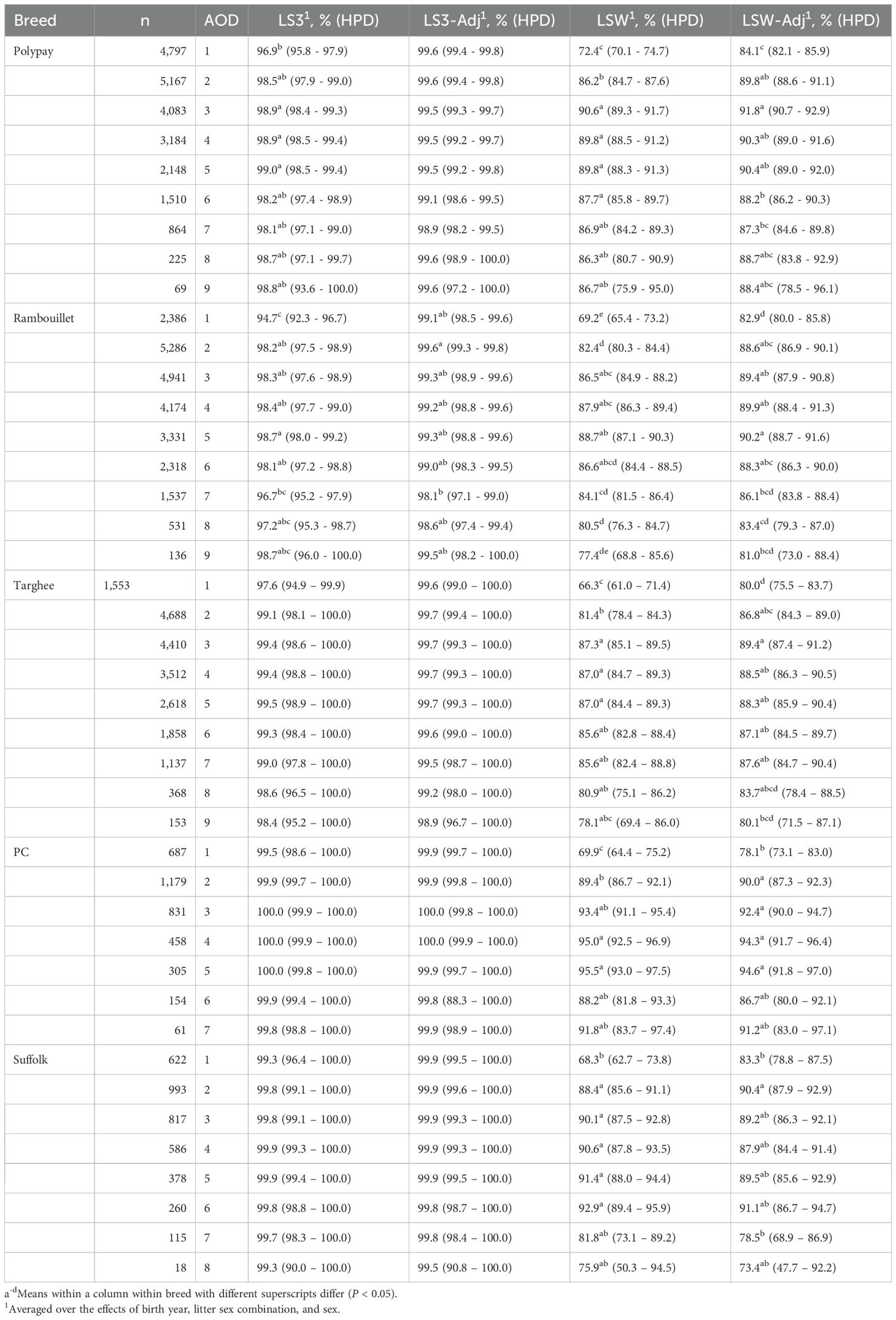
Table 3. Least squares means (LSM) and their 95% highest posterior density (HPD) intervals for lamb survival percentages to 3 days (LS3) and weaning (LSW) and lamb survival percentages to 3 days (LS3-Adj) and weaning (LSW-Adj) adjusted for within-litter birth weight, by age of dam (AOD).
One-year-old Rambouillet ewes had the lowest LS3 but these differences were removed once the LS3-Adj model was applied (Table 3). For LSW, one-year-old ewes had the lowest lamb survivability while 3- to 6-year-old ewes had the highest. With the LSW-Adj model, one-year-old and 7- to 9-year-old ewes had the lowest lamb survivability.
For Targhee, LS3 and LS3-Adj models were not significantly different (P > 0.05) for ewe age (Table 3). For the LSW model, one-year-old ewes had significantly lower lamb survival to weaning than other ages except for 9-year-olds (P < 0.05). With the LSW-Adj model, one-year-old ewes had the lowest lamb survivability (80.0%) followed by 9-year-olds (80.1%) and 8-year-olds (83.7%). The highest lamb survival was for 3-year-old ewes (89.4%).
For the PC, neither the LS3 nor LS3-Adj models were significantly different for ewe age (P > 0.05; Table 3). For LSW, one-year-old ewes had significantly (P < 0.05) lower lamb survivability than the other ewe ages (69.9 vs 88.2 to 95.5%). For LSW-Adj, one-year-old ewes had significantly (P < 0.05) lower lamb survival than 2, 3, 4, or 5-year-old ewes.
There were no significant differences in LS3 or LS3-Adj for Suffolks ewes by age (P > 0.05; Table 3). For LSW, one-year-old Suffolk ewes had the lowest lamb survival while 2- to 6-year-old ewes had significantly higher survival (P < 0.05). Older ewes (7- to 8-year olds) were intermediate and not significantly different from young or mature ewes (P > 0.05). For LSW-Adj, while not statistically significant (P > 0.05), the 7- and 8-year-old ewes had lower lamb survival than one-year-old ewes.
Birth weights for lambs from one-year-old Polypay ewes were significantly lighter than other ewe ages (P < 0.05; Table 4), followed by lambs from 2-year-old ewes who were lighter than the other ewe ages (P < 0.05). The heaviest birth weight lambs were from 4- to 7-year-old ewes. Lambs from 6-year-old ewes weighed 1.03 kg more than lambs from one-year old ewes.

Table 4. Least squares means (LSM) and their 95% confidence limits (CL) for birth weight, by age of dam (AOD).
One-year-old Rambouillet ewes had lambs with lighter birth weights than the other ewe ages (P < 0.05; Table 4). Lambs from 2-year-old ewes were 0.49 kg heavier than lambs from one-year-old ewes (P < 0.05) but were significantly lighter than birth weights from all other ewe ages. The heaviest birth weight lambs were from 5- and 6-year-old ewes and weighed 4.80 kg.
The one-year-old Targhee ewes had lambs with birth weights significantly lighter than those from other ewe ages (P < 0.05; Table 4). Two-year-old ewes had lambs that were 0.61 kg heavier than one-year-old ewes but were significantly lighter (P < 0.05) than lambs from other ewe ages. The heaviest birth weights were from 5-year-old ewes and weighed 5.06 kg, which were 1.09 kg heavier than lambs from one-year-old ewes.
Lamb birth weights from one-year-old PC ewes were 4.73 kg, which were significantly lighter (P < 0.05; Table 4) than the lamb birth weights from other ewe ages. The 2-year-old PC ewes had lambs that weighed 5.64 kg, which were lighter than the birth weights of lambs from 3- to 7-year-old ewes (P < 0.05). Birth weights from mature ewes (3- to 7-year-olds) ranged from 5.98 to 6.09 kg.
Suffolk one-year-old ewes had the lightest birth weight lambs when compared to other ewe ages (P < 0.05; Table 4). The heaviest birth weight lambs were from 6-year-old ewes and those lambs weighed 1.50 kg more than those lambs from one-year-old ewes.
Reasons for and timing of lamb loss
Of the seven categories for lamb loss, the majority for each breed were categorized as other/unknown and ranged from 45% of the loss for the PC and Suffolk to 58% for Targhee (Figure 8). For the Polypay, the next highest category was starvation/exposure (18%), respiratory (9%), and trauma (8%). For the Rambouillet, starvation/exposure lamb loss was 14% followed by respiratory disease at 11%. Similar to the other maternal breeds, the Targhee lost 13% of lambs to starvation/exposure and 9% due to respiratory disease. The PC lost 14% of lambs to predation followed by 12% categorized as weak. Suffolk lambs loss was categorized as 13% for weak lambs, 13% for trauma, and 11% for respiratory disease. Loss due to predation was highest for the PC followed by the Suffolk and was lowest for the three maternal breeds.
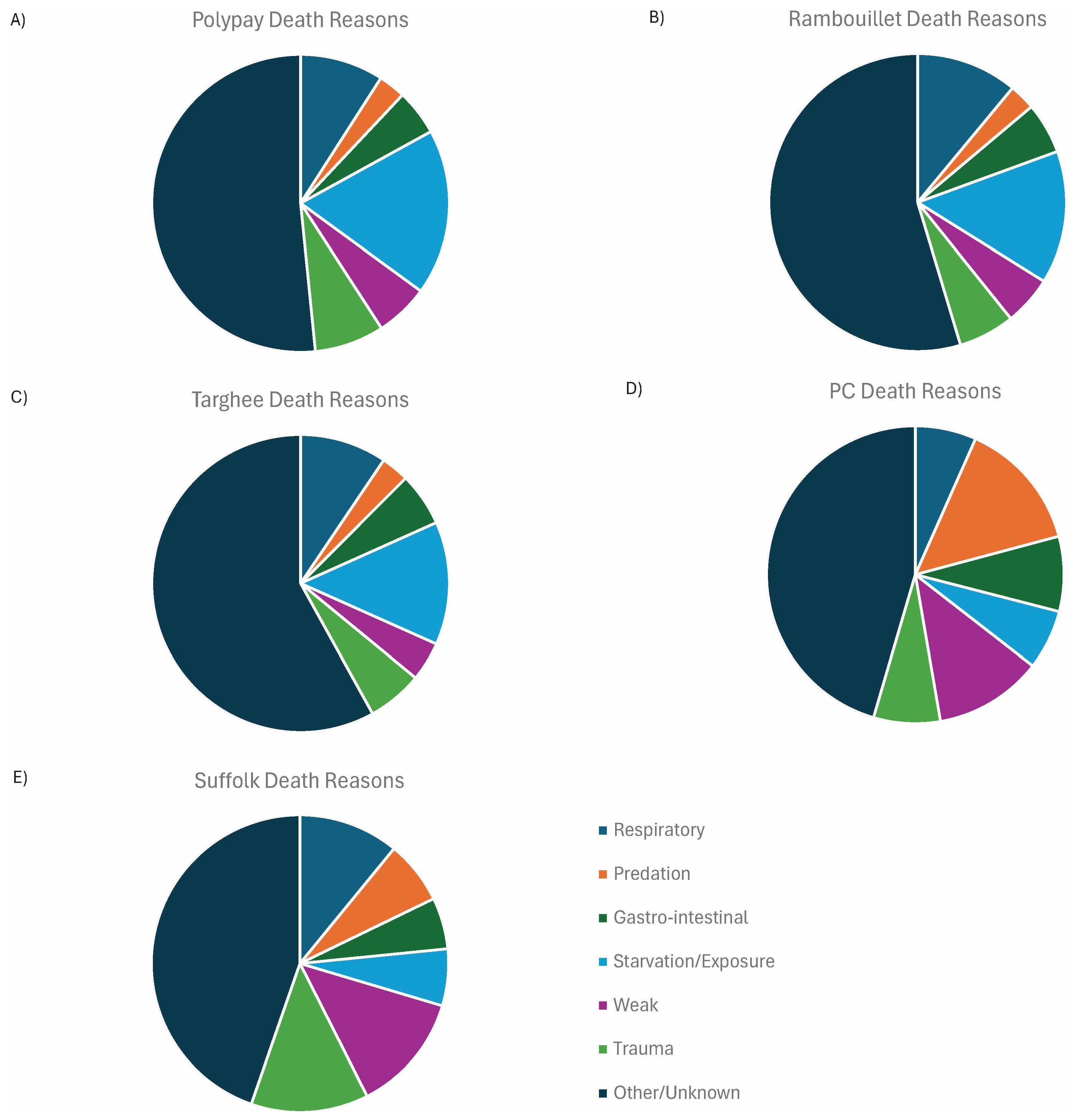
Figure 8. Lamb loss categories by percentage of total lamb loss for Polypay (A), Rambouillet (B), Targhee (C), PC (D), and Suffolk (E).
Death loss for each category occurred at different ages (Figure 9). For all breeds, predation occurred primarily in older lambs after they had been turned out for grazing. Lamb loss due to trauma, which may be associated with dystocia, or weak lambs had a tendency to occur in the first few days of life. The other categories (respiratory, gastro-intestinal, starvation/exposure, other/unknown) had death loss throughout the period from birth to weaning.
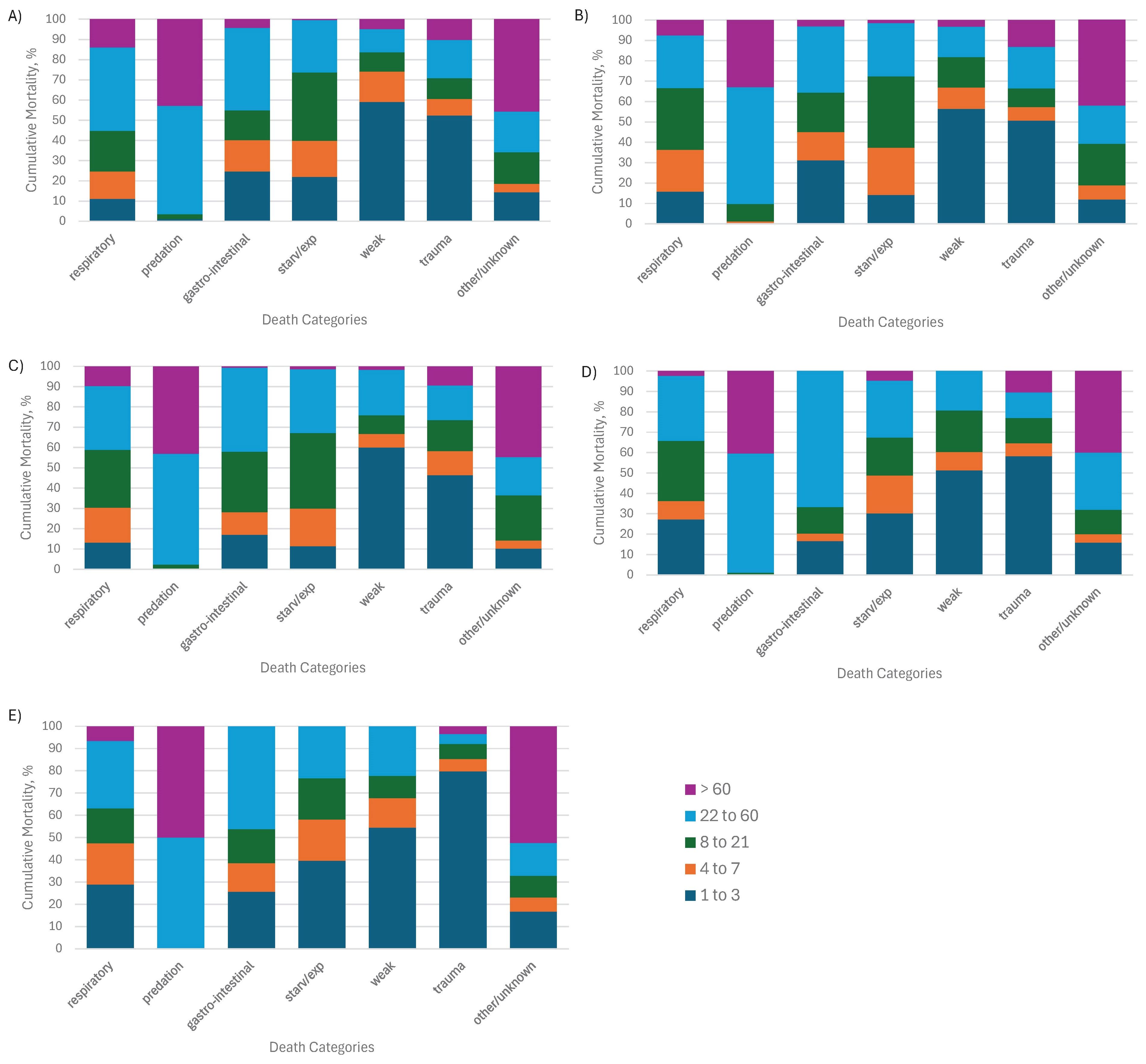
Figure 9. Cumulative mortality for each lamb loss category by age for Polypay (A), Rambouillet (B), Targhee (C), PC (D), and Suffolk (E).
Discussion
Influence of lamb and littermate competition on lamb survivability to weaning
For both the LS3 and LS3-Adj models, no significant differences were found for lamb survivability for any within-litter sex combination for any breed. Lamb survivability least squares means were high (90.5 to 99.9%) despite reports from other researchers where the most lambs were lost in the first few days after birth (Dalton et al., 1980; Everett-Hincks and Dodds, 2008; Everett-Hincks et al., 2014). Higher LS3 was partially due to only intact litters being considered in this study.
When the lamb survivability model (LSW) was adjusted for birth weight (LSW-Adj), twin female lamb survivability least squares means had a tendency to increase while male lamb survivability decreased, suggesting that birth weight is at least partially responsible for lamb survival. At the same time, triplet lamb survivability tended to increase across all litter-sex combinations when adjusted for birth weight. The LSW-Adj model allows for true sex differences to be examined after the birth weight effects have been removed.
Survival is influenced not only by the lamb’s own sex, but also by the sex of its littermate(s). While it is generally accepted that female lamb survivability is higher than for males, only a few studies have examined within-litter sex differences in survival (Donald and Purser, 1956; Korsten et al., 2009; Kenyon et al., 2011) and these were all twin litters. Researchers have reported that increases in litter size result in decreased lamb survivability (Venkatachalam et al., 1949; Dalton et al., 1980; Petersson and Danell, 1985; Lopez-Villalobos and Garrick, 1999; Riggio et al., 2008; Juengel et al., 2018). Across all five breeds in this study, females had higher survival than their male counterparts. For the maternal breeds where triplets were evaluated, singles and twins had higher survivability than triplet litters.
When F in mixed-sex twin litters (FM) were compared to FF litters, survival was not significantly different for any breed. The FF survival was higher than F in FM for Rambouillet, PC, and Suffolk, but lower for the Polypay and Targhee. The MM survival was higher than M in FM for the Polypay, Rambouillet, and Targhee, but lower for the PC and Suffolk. While numeric differences in survival existed between F in FF and FM litters and between M in MM and FM litters, no clear trend emerged. This suggests both F and M are capable of competing with their co-twin for resources. Twin F survival was higher than M survival across all litter-sex combinations for all breeds. While Kenyon et al. (2011) reported higher survival for FF litters than FM and MM litters, the F in FM litters had lower survival than their M co-twin, which was not observed in our study.
For the Polypay and Rambouillet, although not statistically significant, F survival was higher in all female triplet litters (FFF) than when F were in mixed-sex litters. The opposite was observed for the Targhee, where F in mixed-sex triplet litters had higher survivability than the FFF litters. M in FFM and FMM litters had numerical differences in survival which favored the FMM litters for Polypay and Rambouillet and the FFM litters for the Targhee. Clearly, competition is impacting survival in mixed-sex triplet litters, where there is greater competition for limited resources. This supports the suggestion that lamb survival has a different degree of expression for triplets than for twins or singles (Everett-Hincks et al., 2005). Of particular concern is the competition among M in Targhee triplets where M in FMM and M in MMM litters have 70.0 and 66.7% survivability, respectively, compared to 84.5% for M in FFM litters. The F survival is higher across every litter-sex combination. Ewes raising triplets are necessarily facing a limited amount of resources (nutrients) to provide to each lamb. Since F lambs weigh less and require fewer nutrients, it is easier for M in mixed-sex litters to benefit from available nutrients. The M in MMM litters face greater competition for these limited resources, negatively affecting their chances of survival.
Influence of within-litter competition on birth weight
Across all breeds, M were heavier than their F littermates for both twins and triplets (P < 0.05). Although not statistically significant, F lambs were always lighter in mixed-sex litters than in all-female litters. This result was also reported by Korsten et al. (2009) for twin litters. Except for Targhee M in FMM and the PC M in FM, M lambs were heavier in mixed-sex litters than in all-male litters. This is in agreement with Donald and Purser (1956) who suggested males are able to outcompete their female littermates for nutrients in-utero. Since genetic potential for mature body weight of M is much more than F, then F are more likely to meet genetic potential at any stage of life in nutrient challenged states. Accordingly, F could simply meet survival-linked growth requirements when M cannot under nutrient challenge.
Since few M are needed as replacements, selection for more F would be favorable for both replacements and overall lamb survivability. Observed differences in sex ratios have been described in sheep, but selection favoring one sex in sheep is not routine. Theoretical and observed differences based on maternal age and maternal condition (Trivers and Willard, 1973; Martin and Festa-Bianchet, 2011), litter size and timing during the lambing period (Kent, 1992, 1995) provide interesting insight, but do not provide solutions that can be implemented by domestic sheep breeders. More promising solutions were provided by Kumar et al. (2021), who reported differences in sex ratio by ram and Ghavi Hossein-Zadeh (2016), who reported selection for sex ratio as heritable (0.04 – 0.15). Identification of rams who produce more females is worth further investigation.
Relationship between within-litter birth weight deviation and lamb survivability
Lamb survival has typically been characterized by a curvilinear relationship with birth weight, where intermediate birth weights have higher survival (Hight and Jury, 1970; Atkins, 1980; Dalton et al., 1980; Everett-Hincks and Dodds, 2008). In this study, all breeds demonstrated the highest survival for the heaviest lambs and lambs that were heavier than their littermates, suggesting selection against excessively heavy birth weights had already occurred in this flock. Across all breeds, twins with below mean litter weights had lower survival than those with above mean litter weights. Lambs that were much lighter than their co-twin were at a tremendous survival disadvantage. These birth weight differences were further amplified with triplet litters where lambs that were much lighter than their littermates had survival of less than 50%. These results are in agreement with other studies of within-litter birth weight deviation (Everett-Hincks and Dodds, 2008; Morel et al., 2009; Juengel et al., 2018). Although a lamb that is heavier than its littermates has a survival advantage, it necessarily puts its lighter littermate(s) at a survival disadvantage. In order to maximize overall litter survival, it is logical to conclude the most uniform weight litters have the greatest overall chance of survival.
Influence of ewe age on lamb survivability and birth weight
For all breeds, one-year-old ewes and old ewes had the lowest lamb survivability. This was consistent with other studies (Everett-Hincks et al., 2014; Juengel et al., 2018). Of interest is that one-year-old ewes had much lighter lamb birth weights than all other ewe ages, so the reasons for older ewes losing lambs were different than for primiparous ewes. When comparing the terminal sire breeds, who were selected for fast-growing lambs with less emphasis on mothering ability, the PC one-year-old ewes had lower lamb survivability than Suffolk one-year-old ewes (78.1 vs 83.3%). However, the PC ewes that remained in the flock through 7 years maintained high levels of survival (91.2%) while the Suffolk ewes had decreased survivability starting at 7 years (78.5%). The retained heterosis of the PC (Vargas Jurado et al., 2022) is expected to contribute to the fitness of the breed and may partially explain higher lamb survivability at later ewe ages.
Reasons for and timing of lamb loss
Reasons for lamb loss are difficult to identify in extensive grazing systems, which may explain why the other/unknown category comprised the largest category for lamb loss. It is difficult to implement change to improve survival when the reason is ambiguous. Further challenges faced by extensive grazing systems are lamb loss due to predation. The nature of each lamb loss category, including predation, potentially having a genetic, environmental, and genetic by environmental component, make selecting for improvement in lamb survivability challenging. Based on cumulative mortality, predation occurred in older lambs after they were turned out for grazing. Weak and trauma categories had the majority of losses in the first few days of life. An understanding of when lamb loss occurs for each category allows focused management practices to intervene as needed. While the next logical step to improve lamb survivability is to break it into smaller components by reason for lamb loss instead of an all-or-nothing trait, this was proven unsuccessful by both Brown et al. (2014) and Everett-Hincks et al. (2014).
Conclusion
Lamb survivability to weaning was influenced by within-litter competition. While females had higher survivability than their male counterparts, there were differences in survival depending on the sex composition of the litter and was not consistent across breeds. These differences were more pronounced in triplet litters, where there is more competition for limited resources than with twins. Birth weights were significantly heavier for males than their female counterparts. There were non-significant but biologically important differences in birth weight where females in mixed-sex litters were lighter than all-female litters and males in mixed-sex litters were generally heavier than in all-male litters. Suggested management strategies to improve the success of rearing lambs to weaning include 1) close monitoring of primiparous ewes at lambing, including recording a ewe-lamb bonding score, and 2) for fostering or orphaning of triplets, removal of the M in FFM litters and F in FMM litters to improve competition challenges. Suggested genetic improvements include 1) selection for ewe longevity to keep older ewes productive longer, 2) use of a double hierarchical generalized linear model to select for increased number of twins born without an associated increase in triplet and higher order lambs, 3) selection for uniform birth weights, and 4) selection for rams with a higher sex ratio for female lamb production. The results of this study suggest lamb survivability is a different trait for a single, twin, or triplet, and within-litter sex composition should be fit in the model for future genetic evaluation.
Data availability statement
Publicly available datasets were analyzed in this study. This data can be found here: Please contact Carrie Wilson (carrie.wilson@usda.gov) for the dataset used in this research.
Ethics statement
The animal studies were approved by The USSES Institutional Animal Care and Use Committee (IACUC). The studies were conducted in accordance with the local legislation and institutional requirements. Written informed consent was obtained from the owners for the participation of their animals in this study.
Author contributions
CW: Conceptualization, Formal analysis, Methodology, Visualization, Writing – original draft, Writing – review & editing. NC: Data curation, Writing – original draft, Writing – review & editing. JT: Funding acquisition, Writing – original draft, Writing – review & editing.
Funding
The author(s) declare financial support was received for the research, authorship, and/or publication of this article. This project was funded by the USDA-ARS-Range Sheep Production Efficiency Unit (U.S. Sheep Experiment Station).
Acknowledgments
The authors wish to thank the U.S. Sheep Experiment Station animal care staff for animal procedures and data collection. Mention of trade names or commercial products in this publication is solely for the purpose of providing specific information and does not imply recommendation or endorsement by the U.S. Department of Agriculture. The USDA is an equal opportunity provider and employer.
Conflict of interest
The authors declare that the research was conducted in the absence of any commercial or financial relationships that could be construed as a potential conflict of interest.
Publisher’s note
All claims expressed in this article are solely those of the authors and do not necessarily represent those of their affiliated organizations, or those of the publisher, the editors and the reviewers. Any product that may be evaluated in this article, or claim that may be made by its manufacturer, is not guaranteed or endorsed by the publisher.
References
Atkins K. (1980). The comparative productivity of five ewe breeds. 1. Lamb growth and survival. Aust. J. Exp. Agric. 20, 272–279. doi: 10.1071/EA9800272
Bates D., Mächler M., Bolker B., Walker S. (2015). Fitting linear mixed-effects models using lme4. J. Stat. Software 67, 1–48. doi: 10.18637/jss.v067.i01
Brown D. J., Jones R. M., Hinch G. N. (2014). Genetic parameters for lamb autopsy traits. Anim. Production Sci. 54, 736–744. doi: 10.1071/AN13227
Casellas J., Caja G., Piedrafita J. (2007). Genetic determinism for within-litter birth weight variation and its relationship with litter weight and litter size in the Ripollesa ewe breed. Animal 1, 637–644. doi: 10.1017/s1751731107727477
Cloete S. W. P., Misztal I., Olivier J. J. (2009). Genetic parameters and trends for lamb survival and birth weight in a Merino flock divergently selected for multiple rearing ability. J. Anim. Sci. 87, 2196–2208. doi: 10.2527/jas.2008-1065
Dalton D. C., Knight T. W., Johnson D. L. (1980). Lamb survival in sheep breeds on New Zealand hill country. New Z. J. Agric. Res. 23, 167–173. doi: 10.1080/00288233.1980.10430783
Damgaard L. H., Rydhmer L., Løvendahl P., Grandinson K. (2003). Genetic parameters for within-litter variation in piglet birth weight and change in within-litter variation during suckling. J. Anim. Sci. 81, 604–610. doi: 10.2527/2003.813604x
Donald H., Purser A. (1956). Competition in utero between twin lambs. J. Agric. Sci. 48, 245–249. doi: 10.1017/S0021859600030513
Dwyer C., Calvert S., Farish M., Donbavand J., Pickup H. (2005). Breed, litter and parity effects on placental weight and placentome number, and consequences for the neonatal behavior of the lamb. Theriogenology 63, 1092–1110. doi: 10.1016/j.theriogenology.2004.06.003
Everett-Hincks J. M., Dodds K. G. (2008). Management of maternal-offspring behavior to improve lamb survival in easy care sheep systems. J. Anim. Sci. 86, E259–E270. doi: 10.2527/jas.2007-0503
Everett-Hincks J., Lopez-Villalobos N., Blair H., Stafford K. (2002). “Genetic variation in maternal behavior score and lamb survival,” in Proceedings of the 7th world congress on genetics applied to livestock production (Montpelier, France: Wageningen Academic Publishers), 14.
Everett-Hincks J., Lopez-Villalobos N., Blair H., Stafford K. (2005). The effect of ewe maternal behavior score on lamb and litter survival. Livestock Production Sci. 93, 51–61. doi: 10.1016/j.livprodsci.2004.11.006
Everett-Hincks J. M., Mathias-Davis H. C., Greer G. J., Auvray B. A., Dodds K. G. (2014). Genetic parameters for lamb birth weight, survival and death risk traits. J. Anim. Sci. 92, 2885–2895. doi: 10.2527/jas.2013-7176
Fogarty N. M., Hopkins D. L., van de Ven R. (2000). Lamb production from diverse genotypes. 1. Lamb growth and survival and ewe performance. Anim. Sci. 70, 135–145. doi: 10.1017/S1357729800051675
Gama L., Dickerson G., Young L., Leymaster K. (1991). Effects of breed, heterosis, age of dam, litter size, and birth weight on lamb mortality. J. Anim. Sci. 69, 2727–2743. doi: 10.2527/1991.6972727x
Ghavi Hossein-Zadeh N. (2016). Threshold analysis of genetic effects for secondary sex ratio in domestic sheep using Bayesian approach via Gibbs sampling. Small Ruminant Res. 144, 197–204. doi: 10.1016/j.smallrumres.2016.09.019
Goodrich B., Gabry J., Ali I., Brilleman S. (2020). rstanarm: Bayesian applied regression modeling via Stan. (R package version 2.21.1). Available online at: https://mc-stan.org/rstanarm.
Hebart M., Brien F. (2018). “The genetics of lamb survival is different across different birth types,” in Proceedings of the 11th world congress on genetics applied to livestock production (Auckland, New Zealand: University of New England, Armidale, NSW), 703.
Hight G. K., Jury K. E. (1970). Hill country sheep production. New Z. J. Agric. Res. 13, 735–752. doi: 10.1080/00288233.1970.10430507
Holmøy I. H., Waage S., Granquist E. G., L’Abée-Lund T. M., Ersdal C., Hektoen L., et al. (2017). Early neonatal lamb mortality: postmortem findings. animal 11, 295–305. doi: 10.1017/S175173111600152X
Hulet C. V., Ercanbrack S. K., Knight A. D. (1984). Development of the polypay breed of sheep. J. Anim. Sci. 58, 15–24. doi: 10.2527/jas1984.58115x
Hulet C. V., Stellflug J. N. (2019). Accelerated lambing: its role in the sheep industry, Sheep And Goat Handbook Vol. 3 (Boca Raton, FL: CRC Press), 171–178.
Juengel J. L., Davis G. H., Wheeler R., Dodds K. G., Johnstone P. D. (2018). Factors affecting differences between birth weight of littermates (BWTD) and the effects of BWTD on lamb performance. Anim. Reprod. Sci. 191, 34–43. doi: 10.1016/j.anireprosci.2018.02.002
Kelly O., Hebart M., Brien F., Pitchford W. (2016). “Lamb survival should be considered separate genetic traits across different birth types,” in 31st Conference of the Australian Society of Animal Production. (Victoria, Australia: CSIRO Publishing).
Kent J. (1992). Birth sex ratios in sheep over six lambing seasons. Behav. Ecol. Sociobiology 30, 151–155. doi: 10.1007/BF00166697
Kent J. (1995). Birth sex ratios in sheep over nine lambing seasons: years 7–9 and the effects of ageing. Behav. Ecol. Sociobiology 36, 101–104. doi: 10.1007/BF00170714
Kenyon P., Cave L., Blair H., Lopez-Villalobos N., Nicol G. (2011). “Does dam age, ewe birth rank and sex of a co-twin affect a ewe, s lifetime performance,” in Proceedings of the association for the advancement of animal breeding and genetics, (University of New England, Armidale, NSW), 458–461.
Korsten P., Clutton-Brock T., Pilkington J. G., Pemberton J. M., Kruuk L. E. (2009). Sexual conflict in twins: male co-twins reduce fitness of female Soay sheep. Biol. Lett. 5, 663–666. doi: 10.1098/rsbl.2009.0366
Kumar A., Misra S., Sharma R., Gowane G. (2021). Genetic parameters for sex ratio in an organized sheep farm. Indian J. Small Ruminants (The) 27, 31–36. doi: 10.5958/0973-9718.2021.00014.3
Lopez-Villalobos N., Garrick D. (1999). “Genetic parameter estimates for lamb survival in Romney sheep,” in Proceedings-New Zealand society of animal production, (New Zealand Society of Animal Prod), 121–124.
Martin J. G., Festa-Bianchet M. (2011). Sex ratio bias and reproductive strategies: what sex to produce when? Ecology 92, 441–449. doi: 10.1890/09-2413.1
Martin J., Videlier M. (2022). How to fit an animal model an ecologist guide. (Geneva (Switzerland): CERN). doi: 10.5281/zenodo.10891227
Matos C., Thomas D., Young L., Gianola D. (2000). Genetic analyses of lamb survival in Rambouillet and Finnsheep flocks by linear and threshold models. Anim. Sci. 71, 227–234. doi: 10.1017/S1357729800055053
McDonald I., Robinson J., Fraser C. (1981). Studies on reproduction in prolific ewes: 7. Variability in the growth of individual fetuses in relation to intra-uterine factors. J. Agric. Sci. 96, 187–194. doi: 10.1017/S0021859600031981
McKibben H. N., Notter D. R., Stewart W. C., Means W. J., Pierce N. L., Taylor J. B. (2019). Comparison of new composite breeds with the Suffolk breed as terminal sires in an extensive production system: carcass characteristics. Trans. Anim. Sci. 3, 1701–1704. doi: 10.1093/tas/txz061
Morel P., Morris S., Kenyon P. (2009). Effects of birth weight on survival in twin born lambs. Proc. N. Z. Soc Anim. Prod. 69, 75–79.
Mukasa-Mugerwa E., Lahlou-Kassi A., Anindo D., Rege J., Tembely S., Tibbo M., et al. (2000). Between and within breed variation in lamb survival and the risk factors associated with major causes of mortality in indigenous Horro and Menz sheep in Ethiopia. Small Ruminant Res. 37, 1–12. doi: 10.1016/S0921-4488(99)00152-2
Notter D. R., Leeds T. D., Mousel M. R., Taylor J. B., Kirschten D. P., Lewis G. S. (2012). Evaluation of Columbia, USMARC-Composite, Suffolk, and Texel rams as terminal sires in an extensive rangeland production system: II. Postweaning growth and ultrasonic measures of composition for lambs fed a high-energy feedlot diet. J. Anim. Sci. 90, 2941–2952. doi: 10.2527/jas.2011-4641
Notter D. R., Mousel M. R., Leeds T. D., Lewis G. S., Taylor J. B. (2018). Effects of rearing triplet lambs on ewe productivity, lamb survival and performance, and future ewe performance. J. Anim. Sci. 96, 4944–4958. doi: 10.1093/jas/sky364
Notter D. R., Taylor J. B. (2019). Preweaning performance of lambs sired by Suffolk, Siremax composite, and USSES paternal composite rams in an extensive rangeland production system. Trans. Anim. Sci. 3, 1627–1631. doi: 10.1093/tas/txz043
Petersson C. J., Danell ÖCheckt. a. e. (1985). Factors influencing lamb survival in four swedish sheep breeds. Acta Agriculturae Scandinavica 35, 217–232. doi: 10.1080/00015128509435778
R Core Team (2023). “R: the R project for statistical computing,” in R foundation for statistical computing. Ed. Team R. C.(Vienna, Austria).
Riggio V., Finocchiaro R., Bishop S. C. (2008). Genetic parameters for early lamb survival and growth in Scottish Blackface sheep. J. Anim. Sci. 86, 1758–1764. doi: 10.2527/jas.2007-0132
Terrill C. E. (1947). Breed crosses used in the development of Targhee sheep. J. Anim. Sci. 6, 83–92. doi: 10.2527/jas1947.6183
Trivers R. L., Willard D. E. (1973). Natural selection of parental ability to vary the sex ratio of offspring. Science 179, 90–92. doi: 10.1126/science.179.4068.90
USDA-NASS (2021). (National Agriculture Statistics Service (NASS). Available online at: https://www.nass.usda.gov/Data_and_Statistics/ (Accessed December 1 2021).
USDA-NASS (2024). Sheep and goats. Available online at: https://usda.library.cornell.edu/concern/publications/000000018 (Accessed 8/9/2024).
USTSA (2023). (U.S. Targhee Sheep Association). Available online at: https://www.targheesheepus.com/ (Accessed 8/28/2023).
Vanimisetti H. B., Notter D. R. (2012). Opportunities for genetic evaluation of reproductive performance in accelerated lambing systems. Livestock Sci. 148, 134–145. doi: 10.1016/j.livsci.2012.05.022
Vargas Jurado N., Notter D. R., Taylor J. B., Brown D. J., Mousel M. R., Lewis R. M. (2022). Model definition for genetic evaluation of purebred and crossbred lambs including heterosis. J. Anim. Sci. 100. doi: 10.1093/jas/skac188
Venkatachalam G., Nelson R. H., Thorp F. Jr., Luecke R. W., Gray M. L. (1949). Causes and certain factors affecting lamb mortality. J. Anim. Sci. 8, 392–397. doi: 10.2527/jas1949.83392x
Welsh C. S., Garrick D. J., Enns R. M., Nicoll G. B. (2006). Threshold model analysis of lamb survivability in Romney sheep. New Z. J. Agric. Res. 49, 411–418. doi: 10.1080/00288233.2006.9513732
Keywords: lamb survival, birth weight, sheep, competition, welfare, predation
Citation: Wilson CS, Cherry NL and Taylor JB (2025) Lamb survivability: a new approach to an old problem. Front. Anim. Sci. 6:1497380. doi: 10.3389/fanim.2025.1497380
Received: 16 September 2024; Accepted: 06 January 2025;
Published: 23 January 2025.
Edited by:
Ashish Chopra, Central Sheep and Wool Research Institute (ICAR), IndiaReviewed by:
Gopal Gowane, Indian Council of Agricultural Research (ICAR), IndiaRansom L. Baldwin, United States Department of Agriculture, United States
Copyright © 2025 Wilson, Cherry and Taylor. This is an open-access article distributed under the terms of the Creative Commons Attribution License (CC BY). The use, distribution or reproduction in other forums is permitted, provided the original author(s) and the copyright owner(s) are credited and that the original publication in this journal is cited, in accordance with accepted academic practice. No use, distribution or reproduction is permitted which does not comply with these terms.
*Correspondence: Carrie S. Wilson, Y2FycmllLndpbHNvbkB1c2RhLmdvdg==
 Carrie S. Wilson
Carrie S. Wilson Natalie L. Cherry
Natalie L. Cherry J. Bret Taylor
J. Bret Taylor